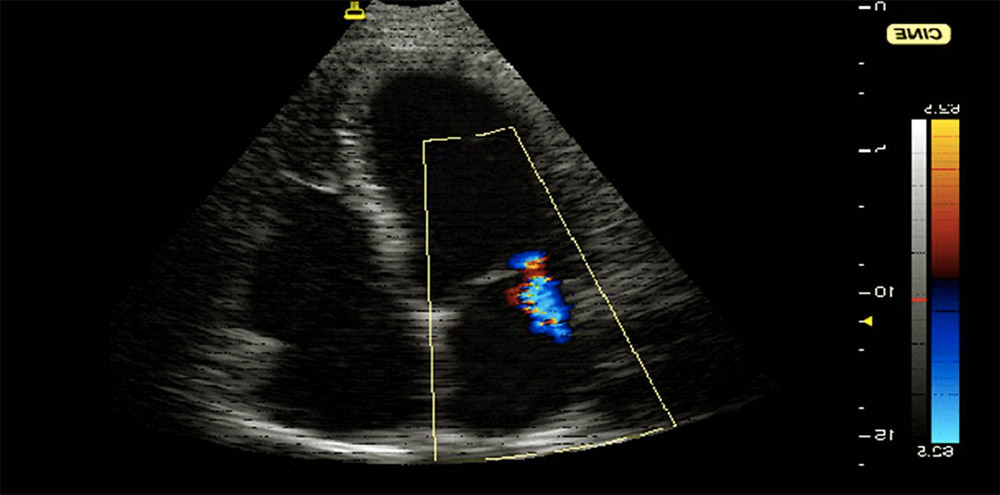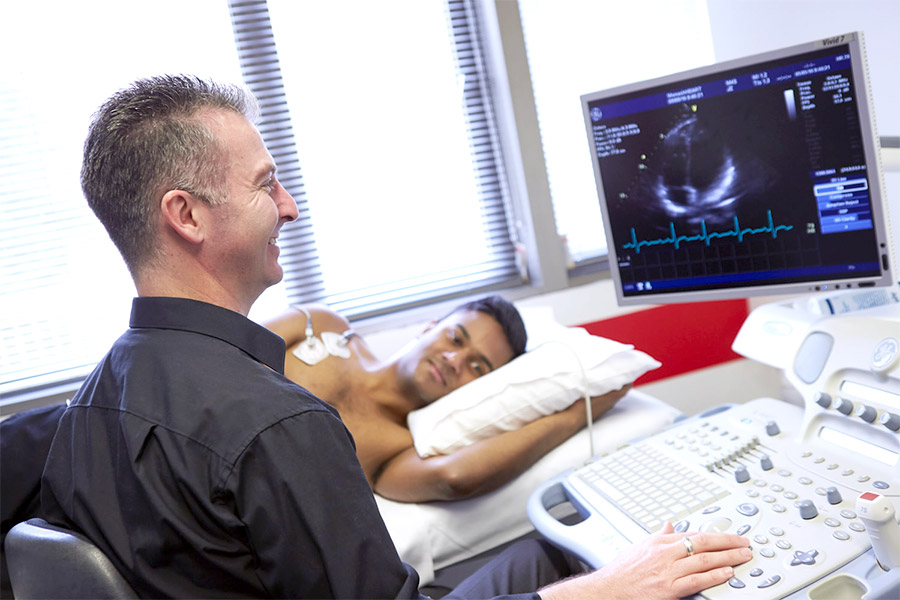Regurgitation is a term used for a backward flowing of a body fluid such as in vomiting or in blood flow. In mitral valve regurgitation, the blood sloshes back to the left heart atrium when it is supposed to be flowed out to the left ventricle.
In simpler term, the blood leaks in a reversed direction because the left valve of the heart is defective. In a different name, the mitral valve regurgitation may also be called as mitral valve insufficiency.
The human heart has four chambers – two upper chambers which are called the atrium and two lower chambers which are called the ventricles. Each set of the chambers lay on two sides, left and right, and connected with valves. These valves open and closes to let the blood flows from the atrium to the ventricle.
The mitral valve regurgitation can be recognized if someone has trouble in breathing, has a blood murmuring sounds from the heart, or swollen ankles. Furthermore, there are other symptoms, and some people may survive without any symptoms for years before the leakage gets worse.
In each case, the severity and causes of the mitral valve regurgitation may be different. The disease also tends to progress gently. Thus, some people may not recognize the disease especially when there are no symptoms occur. Further checkup and observation may need to be performed to get the complete diagnosis.
Types of Mitral Valve Regurgitation

There are basically four types of mitral valve regurgitation. The causes and the physiologic state of the valve may be different for each type of the disease. To each type, the level of treatment may also be varied and may need particular intervention.
To know further about the mitral valve regurgitation, below are the four types of the disease:
Trace, Trivial, or Mild Mitral Valve Regurgitation
Trace mitral valve regurgitation is the mildest type of the disease. Often, it does not show any symptoms and can be left untreated unless the symptoms get worse within time. This abnormality on the valve may occur because of ischemic heart disease, dilated cardiomyopathy, endocarditis, or congenital pathology.
Moderate Mitral Valve Regurgitation
In moderate cases, the valve leaks around 30% of blood backward. The muscles may be deformed due to ischemic heart disease, endocarditis, and rheumatic diseases. The leaflets on the valve may seem to be swollen, elongated, or ruptured.
Severe Mitral Valve Regurgitation
Severe mitral valve regurgitation refers to a condition where the 50% of the blood flow backward. This may happen to someone who has been having a rheumatic disease for years. Most commonly, the annulus around the valve develops calcium buildups which make it hardened.
Torrential Mitral Valve Regurgitation
Torrential mitral valve regurgitation can be considered as the most serious type of the disease. Mostly, the valve leaflets are flailed so that it cannot hold the leakage anymore. In this case, most of the blood flows back to the atrium.
Signs and Symptoms

In some cases, the symptoms do not appear for years, especially for chronic mitral valve regurgitation. Otherwise, the symptoms come suddenly in acute regurgitation cases. Sometimes, the symptoms are unrecognizable. It will be more likely to appear when you are doing heavy activities, and the most general symptoms are:
- Difficulty in breathing
- Weakness, or fatigue feeling
- Swollen feet and ankles
- Murmuring sound from the heard, indicating atrial fibrillation
Those symptoms occur for the primary mitral valve regurgitation. In secondary cases, the symptoms happening are those which indicating heart problems such as coronary artery disease or heart failure.
As for acute mitral valve regurgitation, the condition which the patient face is most likely to be an emergency, the valve regurgitation signs happen suddenly. Your heart can develop acute mitral valve regurgitation later after you suffer from other heart problems. These conditions may be the sign of any heart problem happening inside of the body:
- Severe shortness of breath
- Rapid heart rate
- Weakness
- Feel perplexed
- Chest pain
- Lightheadedness
If you caught one or more of those symptoms, it is recommended that you directly go to the hospital to get a checkup. You may need to go through an ultrasonography, x-ray photograph, or undergo any scan or other procedures told by the doctor.
Causes
The mitral valve regurgitation may have two forms, the chronic and acute condition. The chronic mitral regurgitation means that the problem has been occurring for years and leads to mitral valve regurgitation. While in the acute condition, the problem happens unexpectedly in a short period of time.
There are two classifications of causes in chronic mitral valve regurgitation, they are:
The Primary Mitral Regurgitation Causes
The primary causes happen when there are problems with the valve’s anatomy. The valve might harden or softened for some reasons.
It is the most common causes of the mitral valve regurgitation. The leaflets of the valve are thickened, giving it a softer texture. Once it becomes soft, the valve can no longer hold the blood and eventually will lead to leakage.
Broken Chord
There are strings which hold the valve in place and give it the pumping movements. In one of the cases, the string may fall out and weaken the valve position. This makes the valve defective and deformed. It may lead to a worse case of torrential mitral valve regurgitation.
Mitral Valve Endocarditis
This happens when one of the valve tissues is destroyed due to infection. The valve may have a hole in it and leak the blood back to the heart atrium.
Valve Calcification
Due to age and malnutrition, some parts of our body can have calcium buildup. It can happen to the heart valves, too. The calcium accumulates on the valves edges and interferes with the blood flowing through the valves. The advanced type of this valve is called the valve stenosis where the calcium narrows down the valve and causing mitral valve regurgitation.
Secondary Mitral Regurgitation Causes
The secondary mitral valve regurgitation may occur because of other diseases that affect the valve’s muscles. Because the muscles are affected, the valve may not be working properly.
Heart Failure
In some cases of heart failure, the heart size enlarges or swollen. It then can cause the mitral valve cannot opens and closes perfectly – causing blood to leak and flow backward.
Coronary Artery Disease
The coronary arteries are the organ which supplies blood to the muscles, including heart’s muscles that control the mitral valve. When the coronary arteries do not supply enough blood to the mitral valve muscles, or even have a blockage, the function of the valve can be disrupted and lead to mitral valve regurgitation.
Heart Attack Complication
In a heart attack, the papillary muscles cannot work properly to maintain the mitral valve movement. In some cases, the muscles might suffer from a rupture causing a further case of torrential mitral valve regurgitation.
Hypertrophic Cardiomyopathy
In hypertrophic cardiomyopathy, the heart muscle is severely thickened. It often affects the blood flow and eventually causes the mitral valve to distort. Once the mitral valve is distorted, the regurgitation can easily happen.
In acute mitral valve regurgitation, the problem comes suddenly and can be caused by chest injuries. Acute mitral valve regurgitation can also happen to those who have done under a valve surgery and receive prosthetic valve leaflets.
How to Diagnose

Since the symptoms can be difficult to recognize, the chronic mitral valve regurgitation can also be hard to diagnose. Sometimes, a chronic patient has the disease for decades before he or she realizes that there is something wrong with their heart. In addition, the symptoms can be confused with other heart disease and abnormality.
To check your condition, it is recommended that you take a routine checkup or consult with a relating doctor even when you have mild symptoms. The first sign that needs to be concerned is heart murmuring.
However, the acute mitral valve regurgitation is a lesser frequent case compared with the chronic condition. In acute cases, the symptoms come unexpectedly and occur quickly. A patient may have a chest injury or sudden attack similar to a heart attack before diagnosed with acute mitral valve regurgitation.
Basically, diagnosing mitral valve regurgitation can only be done once your doctor suspects the condition. To get the information, you may start a routine doctor consultation to monitor your health. Once you have one or more mitral valve regurgitation symptoms, further examination through these procedures may be done:
- Medical history and symptoms review: the doctor will interview you to ask whether there are symptoms like shortness of breath, chest pain, or fatigue feeling occur.
- Physical examination: test the blood pressure, heart pulse rate, examine, heart and lung through a stethoscope, check physical condition for signs of edema and vein abnormality.
- Echocardiogram: an ultrasound examination to determine the severity of the mitral valve regurgitation. The structure, size, and function problems in the mitral valve can be revealed from the procedure.
- Electrocardiogram: measure the electrical signal to examine any abnormal activity in the heart through checking the heartbeat rhythm.
- X-Ray Photograph: the x-ray imaging can tell any abnormal enlargement of the heart size. The heart’s calcification can sometimes be seen from the x-ray image.
- Magnetic Resonance Imaging (MRI): it scans the heart to find out the remaining function of the heart in pumping blood. It can also tell how severe the mitral valve regurgitation is.
- Cardiac catheterization: this is one of the advanced tests to check the severity of the mitral valve regurgitation and see the real problem on the physical state of the heart.
To avoid getting a late diagnosis, you need to do a regular echocardiogram especially when you have been suspected with mitral valve regurgitation problem. Someone with mild or no problem in the mitral valve should at least have their echocardiogram done every 3 to 5 years.
Once you are diagnosed with a moderate level of severity, you may need to recheck your echocardiogram every 1 to 2 years, and more frequent if you are diagnosed with a severe mitral valve regurgitation.
Risk Factors
The problem of mitral valve regurgitation may appear without any symptoms and can be caused by many things related to the heart’s health. If you have one or more of these below conditions, you have a bigger risk of mitral valve regurgitation:
- Aging: if you are over 50 years old, the risk of getting valve leakage is bigger. You may need to start a routine checkup to prevent the problem.
- Rheumatic Fever: if you have had a rheumatic fever for the past years, it may cause scars on the heart valve. Due to scars, the valve may not close and open properly, causing leakage.
- Mitral Valve Prolapse: when the mitral valve between the left atrium and ventricle sinks or prolapses. In mild cases, mitral valve prolapse does not need any special treatment unless it leads to mitral valve regurgitation.
- Heart Failure or Coronary Artery Disease: these health problems can alter the structure of the mitral ventricle, causing it to work improperly.
Treatment
While some of the trivial cases of mitral valve regurgitation do not need any special treatment, the aim of the intervention on the problem is to get the valve to work properly. However, if there is any sign of mitral valve regurgitation appear, you may have to see the doctor regularly and monitor the work of your heart to avoid further complications.
Medications
Most of the mitral valve regurgitation condition is the deformity of the valve. In this case, medication cannot help in bringing the valve back to shape. What medications do is lowering the risk of the problem to get more severe.
For example, mitral regurgitation patient with edema may have a prescription of diuretics to get rid of water excess in the body. Another example is a prescription of blood pressure controller for a patient with high blood pressure. If the problem persists and may have other complications, a surgery may need to be performed.
Surgery
The surgery performed should depend on the base of the problem. The valve may be repaired by connecting the flail leaflets, repairing broken chord, tightening the structure around the valve, or removing excess tissue when heart enlargement occurs.
If the valve cannot be repaired, a valve replacement may need to be done. The replacement can use the mechanical or bioprosthetic valve. Due to this, the patient with replaced valve should take medicines to prevent complication due to the machine.
The mitral valve regurgitation—either chronic or acute—affect 5 in every10,000 people. It is the most common heart problem after aortic stenosis. Many of the cases are left undetected due to mild or no symptoms. To avoid it, checkup and doctor visit must be done regularly.




3 Comments
This was very informative. My Mother is 92 years old. about 12 years ago she had an echocardium when she broke her femur and may have had Mitral valve leakage and last Monday she went into hospital with dehydration and diarrhea and atrial fibrillation also low potassium.
They determined she also had a parasite, chritospiridium. She is very clean and I have no idea how she could have contracted that. On wednesday morning she had a stroke. She now is in a nursing home, sitting up, talking better and more angility in her right arm. She is so organized and the Dr. said she is a miracle. Yet the PA said she has 3 months to live?? Could this have been prevented. She is my dads major care giver and was driving days before this occurred. Oh well she is in Gods hands.
My Daughter is 8 years old. Since she was 2 years old, she used to have joints pain in her anckles and can’t walk. During her peroid of growing up she faces the pain oftenly. Last year June 2019, She got fever so I take her to the hospital and was check. The Doctor told me that she had a Phenumatic Mitral Valve Regurgitation. I was shocked. How can a small 8 year old kid got such a disease? We saw the Heart Specialist and now she was on her Medication. How can I help her to recover Valve?
but anywhere just leave everything on Gods hands and let God to be her Doctor.
We are going to our second review down at Port Moresby.
could doing a high intensity activity, example tree lopping and working out in a gym after being fairly passive for up to twelve months cause a mitral regurgition/ heart valve leakage